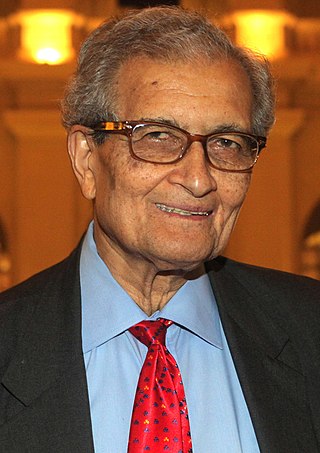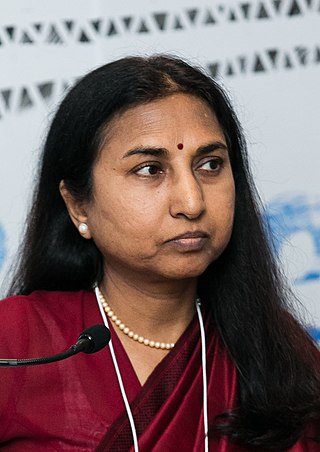Related Research Articles

Amartya Kumar Sen is an Indian economist and philosopher. Sen has taught and worked in England and the United States since 1972. In 1998, Sen received the Nobel Memorial Prize in Economic Sciences for his contributions to welfare economics. He has also made major scholarly contributions to social choice theory, economic and social justice, economic theories of famines, decision theory, development economics, public health, and the measures of well-being of countries.

The Maratha Confederacy, also referred to as the Maratha Empire, was an early modern polity in the Indian subcontinent. It comprised the realms of the Peshwa and four major independent Maratha states often subordinate to the former. It was established in 1674 with the coronation of Shivaji as the Maratha Chhatrapati and recognised by Emperor Bahadur Shah I as a tributary state in 1707 following a prolonged rebellion. Following this, the Marathas continued to recognise the Mughal emperor as their nominal suzerain, similar to other contemporary Indian entities, though in practice, imperial politics at Delhi were largely influenced by the Marathas between 1737 and 1803.
Rajput, also called Thakur, is a large multi-component cluster of castes, kin bodies, and local groups, sharing social status and ideology of genealogical descent originating from the northern part of the Indian subcontinent. The term Rajput covers various patrilineal clans historically associated with warriorhood: several clans claim Rajput status, although not all claims are universally accepted. According to modern scholars, almost all Rajput clans originated from peasant or pastoral communities.

Bethune College is a women's college located on Bidhan Sarani in Kolkata, India, and affiliated to the University of Calcutta. It is the oldest women's college in India. It was established as a girls' school in 1849, and as a college in 1879.
Usha Sanyal is an Indian scholar and historian of Islam specializing in the Barelvi movement. She was a visiting assistant professor of history at Wingate University in North Carolina.

Devaki Jain is an Indian economist and writer, who has worked mainly in the field of feminist economics. In 2006 she was awarded the Padma Bhushan, the third-highest civilian award from Government of India, for her contribution to social justice and the empowerment of women.

The maharaja of Mysore was the king and principal ruler of the Kingdom of Mysore and briefly of Mysore State in the Indian Dominion roughly between the mid- to late-1300s and 1950. The maharaja's consort was called the maharani of Mysore.

Before India gained independence in 1947, India was divided into two sets of territories, one under direct British rule, and the other consisting of princely states under the suzerainty of the British Crown, with control over their internal affairs remaining in the hands of their hereditary rulers. The latter included 562 princely states which had different types of revenue-sharing arrangements with the British, often depending on their size, population and local conditions. In addition, there were several colonial enclaves controlled by France and Portugal. After independence, the political integration of these territories into an Indian Union was a declared objective of the Indian National Congress, and the Government of India pursued this over the next decade.
The All India States Peoples' Conference (AISPC) was a conglomeration of political movements in the princely states of the British Raj, which were variously called Praja Mandals or Lok Parishads. The first session of the organisation was held in Bombay in December 1927. The Conference looked to the Indian National Congress for support, but Congress was reluctant to provide it until 1939, when Jawaharlal Nehru became its president, serving in this position till 1946. After the Indian Independence, however, the Congress distanced itself from the movement, allying itself with the princely rulers via its national government's accession relationships.

Cornelia Sorabji was an Indian lawyer, social reformer and writer. She was the first female graduate from Bombay University, and the first woman to study law at Oxford University. Returning to India after her studies at Oxford, Sorabji became involved in social and advisory work on behalf of the purdahnashins, women who were forbidden to communicate with the outside male world, but she was unable to defend them in court since, as a woman, she did not hold professional standing in the Indian legal system. Hoping to remedy this, Sorabji presented herself for the LLB examination of Bombay University in 1897 and the pleader's examination of Allahabad High Court in 1899. She became the first female advocate in India but would not be recognised as a barrister until the law which barred women from practising was changed in 1923.

The Chamber of Princes was an institution established in 1920 by a royal proclamation of King-Emperor George V to provide a forum in which the rulers of the princely states of India could voice their needs and aspirations to the colonial government of British India. It survived until the end of the British Raj in 1947.

Bina Agarwal is an Indian development economist and Professor of Development Economics and Environment at the Global Development Institute at The University of Manchester. She has written extensively on land, livelihoods and property rights; environment and development; the political economy of gender; poverty and inequality; legal change; and agriculture and technological transformation.

The Phulkian Dynasty of Maharajas or sardars were Sikh royals and aristocrats in the Punjab region of India. Members of the dynasty ruled the states of Badrukhan, Bhadaur, Faridkot, Jind, Malaudh, Nabha, and Patiala, allying themselves with the British Empire according to the terms of the Cis-Sutlej treaty of 1809. The dynasty is named after Phul Sidhu-Brar, the 17th-century common ancestor of the Phulkian states and the founder of the Phulkian Misl. Members of the Phulkian dynasty, who are the direct descendants of Rawal Jaisal Singh, the founder and ruler of the Kingdom of Jaisalmer, migrated to the present-day Malwa region in Punjab.

After the Indian Rebellion of 1857, the British Government took over the administration to establish the British Raj. The British Raj was the period of British Parliament rule on the Indian subcontinent between 1858 and 1947, for around 89 years of British occupation. The system of governance was instituted in 1858 when the rule of the East India Company was transferred to the Crown in the person of Queen Victoria.

Margaret Elizabeth Cousins was an Irish-Indian educationist, suffragist and Theosophist, who established All India Women's Conference (AIWC) in 1927. She was the wife of poet and literary critic James Cousins, with whom she moved to India in 1915. She is credited with preserving the tune of the Indian National Anthem Jana Gana Mana based on the notes provided by Tagore himself in February 1919, during Rabindranath Tagore's visit to the Madanapalle College. She was a member of the Flag Presentation Committee which presented the National Flag to the Constituent Assembly on 14 August 1947.

The practice of prostitution in colonial India was influenced by the policies of British rule in India. During the 19th and 20th centuries the colonial government facilitated, regulated and allowed the existence of prostitution. Not only was prostitution in India affected by the policy of the Governor General of India, it was also influenced by the moral and political beliefs of the British authorities, and conflicts and tensions between the British authorities and the Indian populace at large. The colonial government had a profound effect on prostitution in India, both legislatively and socially.
The New Cambridge History of India is a major multi-volume work of historical scholarship published by Cambridge University Press. It replaced The Cambridge History of India published between 1922 and 1937.
The Jat people are a traditionally agricultural community in Northern India and Pakistan. Originally pastoralists in the lower Indus river-valley of Sindh, many Jats migrated north into the Punjab region in late medieval times, and subsequently into the Delhi Territory, northeastern Rajputana, and the western Gangetic Plain in the 17th and 18th centuries. Of Hindu, Muslim and Sikh faiths, they are now found mostly in the Indian states of Punjab, Haryana, Uttar Pradesh and Rajasthan and the Pakistani provinces of Sindh and Punjab.
Modern historians agree that Rajputs consisted of a mix of various different social groups and different varnas. Rajputisation explains the process by which such diverse communities coalesced into the Rajput community.

Lakshmibai Rajwade (1887–1984) was an Indian medical doctor, feminist, and family planning advocate. She was also a suffragist and advocate for the right of women to vote in India, and presided over the All India Women's Conference as well as acting as its secretary. She was the author of an influential report on the role of women in the Indian economy in 1938, as well as a driving force in the adoption of family planning measures as part of the agenda of the Indian independence movement. Rajwade also represented India internationally, at the United Nations and helped establish links between Indian women's organizations and international women's organizations.
References
- ↑ Marquis Who's Who (1994). Who's Who in the Midwest, 1994-1995. Marquis Who's Who, LLC. ISBN 9780837907246 . Retrieved 8 October 2014.
- ↑ "Faculty page at University of Cincinnati". University of Cincinnati . Retrieved 11 April 2015.
- ↑ BHAGAT, ASHRAFI S (21 October 2008). "Portraiture of Indian royal courts". The Hindu . Archived from the original on 6 February 2010. Retrieved 28 January 2010.
- ↑ Ahmed, Razi U.; Yaqoob K. Bangash (8 January 2008). "The fog of a legacy". Dawn. Retrieved 28 January 2010.
- ↑ Ramusack, Barbara N. (1969-05-01). "Incident at Nabha: Interaction between Indian States and British Indian Politics". The Journal of Asian Studies. 28 (3): 563–577. doi: 10.2307/2943179 . JSTOR 2943179.